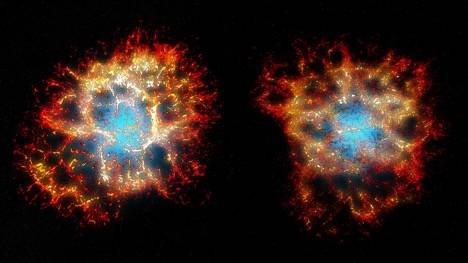The equinox, mauiili, refers to equal nights — a day in which time is split equally between darkness and sunlight — and occurs twice annually, once in the spring and again in the fall.
On March 19 at 11:37 p.m., the sun will cross the earth’s equator heading north, and we will wake up in Hawaii to the first day of spring, while our cousins in the Southern Hemisphere will awaken to the first day of fall.
Equinox is a Latin word, a combination of “aequus,” meaning “equal,” and “nox,” meaning “night”; it occurs on only two days of the year when the sun rises due east, Hikina, and sets due west, Komohana.
Featured Mauna Kea discovery/observation
Beneath the lowest star of the shape Hokulei (Auriga or Capella), observers with a very good telescope would be able to find a unique and somewhat famous nebula, M-1, also known as the Crab Nebula.
The Crab Nebula is the remnant of a massive star that died as a great supernova explosion; many scholars conclude that the light of this supernova event was first observed by Chinese astronomers in the year 1054 when a bright “guest star” appeared in the sky and remained visible even during the day for three months.
Today astronomers are carefully observing the gas of the nebula, which is still expanding outward from this explosive event, to help them learn more about the Crab Nebula; many questions remain about what type of star started the supernova and what type of supernova took place.
However, humanity has always been limited to one view of the Crab Nebula. Our place in the universe meant that we were unable to take a 360-degree picture of the full nebula and had been limited to only a 2D snapshot, until now.
Utilizing the powerful SITELLE spectrograph at the Canada France Hawaii Telescope on Mauna Kea, researcher Thomas Martin of Laval University in Quebec created a new 3D reconstruction of the Crab Nebula.
“Astronomers will now be able to move around and inside the Crab Nebula and study its filaments one by one,” Martin said.
Supernovae, like the one that triggered the Crab Nebula, are so powerful that they help create the fundamental complex elements that build up our world and the universe around us. By further studying these unique events, scientists can unlock the secrets of our atomic structures’ origins.
To learn more about this unique project, which allows astronomers to take a never-before-seen look into this famous astronomical object, and to watch a video of the exploration, visit cfht.hawaii.edu/en/news/HeartofTheCrab.
Evening observations
This is the last month to celebrate the first of our four star families, Kekaomakali‘i, The Bailer of Makali‘i, the metaphorical celestial canoe bailer that appears to be scooping up stars on the eastern horizon, carrying them overhead and pouring them out and into the western horizon.
The Bailer is formed by Hokulei in the northeast and continues on a southward arc that forms the shape of the scoop of the bailer toward Nanamua and Nanahope (Castor and Pollux) in the twin stars of Gemini; to Puana (Procyon) in Canis Minor; to ‘A‘a (Sirius) in Canis Major; and to Keali‘ikonaikalewa (Canopus), which form the handle of the celestial canoe bailer.
Dominant in the middle of the Bailer are the three stars in the constellation Kaheiheionakeiki (Orion’s Belt): Mintaka, Alnilam and Alnitak. These three stars form an equatorial asterism that traces a line across the celestial equator, from east to west.
Thirty years ago members of the Polynesian Voyaging Society’s Hawaiian Astronomy Committee chose the name Kaheiheionakeiki, “the string games inherited by the generations.” The committee saw all the constellations through the metaphor of string games that were preserved for the generations; people and cultures could make up their own stories for the images they observed in the night sky.
Kaheiheionakeiki straddles the celestial equator and can be seen by most cultures in the Northern and Southern hemispheres.
Another prominent asterism that can be traced in the western evening sky is the Winter Hexagon, also known as the Winter Circle. It is formed by drawing lines between Puanakau, Rigel in Orion; Kapuahi, Aldebaran in Taurus; Hokulei in Auriga; Nanamua and Nanahope in Gemini; Puana in Canis Minor; and ‘A‘a in Canis Major.
‘A‘a and Puana are also part of the smaller Winter Triangle asterism when joined with Kauluakoko, Betelgeuse in Orion.
Morning observations
The early morning sky offers up a whole different perspective of the universe.
In March, dawn will color our sky at around 5:30 a.m., and the sun will rise between 6:51 and 6:24 a.m. In these early morning hours, the luminous planets Saturn, Jupiter and Mercury will be visible in the southeastern sky.
Jupiter will stand out in particular as one of the brightest objects in the sky.
On Thursday the faint planet Mercury will have a close encounter with Jupiter. Mercury is known as one of the hardest planets to observe, as it will be very close to the horizon just before the sun rises.
The best day to view Mercury is on Saturday, when it will be at Greatest Western Elongation, its highest position on the horizon.
March 2021 Sky Chart by Honolulu Star-Advertiser
Chad Kalepa Baybayan (Kalepa.Baybayan@hawaii.edu) serves as navigator-in-residence and Emily Peavy (Emily.Peavy@hawaii.edu) as planetarium technician support facilitator at the ‘Imiloa Astronomy Center of Hawaii, a center for informal science education at the University of Hawaii at Hilo showcasing astronomy and Hawaiian culture as parallel journeys of human exploration.

